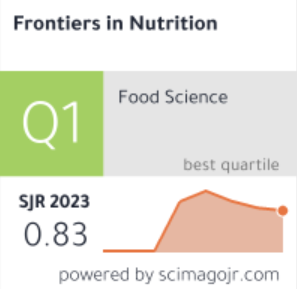Factors associated with dietary patterns (DPS) and nutritional status among pregnant women in AM-HDSS, South Ethiopia
IF 4
2区 农林科学
Q2 NUTRITION & DIETETICS
引用次数: 0
Abstract
BackgroundMalnutrition during pregnancy increases the risk of chronic illness later in life and adverse birth outcomes in subsequent generations. In this regard, consumption of diets rich in adequate energy, protein, vitamins, and minerals from a variety of foods is essential. Evidence on the status of maternal dietary pattern is very crucial. Hence, the aim of this study was to assess factors associated with dietary patterns and nutritional status of pregnant women in South Ethiopia.MethodsA community-based cross-sectional study was conducted among 638 randomly selected pregnant women using a validated, a pre-tested, contextualized food frequency questionnaire using interviewer-administered structured questionnaire by digital open-source toolkit. Principal component factor analysis was employed to determine dietary patterns. Bivariable and multivariable ordinal logistic regression analyses were used to identify factors associated with dietary patterns and nutritional status, using STATA version 16.ResultThe dietary habits of pregnant women were best explained by three distinct dietary patterns. Urban dwellers (AOR = 2.18; 95% CI: 1.33, 3.59), from high socio-economic status (AOR = 2.43; 95% CI: 1.68, 3.51), from middle socio-economic status (AOR = 1.72; 95% CI: 1.19, 2.48), primigravida mothers (AOR = 1.72; 95% CI: 1.07, 2.78), and multigravida mothers (AOR = 2.08; 95% CI: 1.39, 3.10) were high likelihood to consume the highest tercile of “Cereals-Pulses and Dairy” compared to rural dwellers, from low socio-economic status and grand multigravida, respectively. Attending formal education (AOR = 1.60; 95% CI: 1.02, 2.51), from higher socioeconomic status (AOR = 1.56; 95% CI: 1.02, 2.38), not having food aversion (AOR = 1.98; 95% CI: 1.16, 3.39), and had good dietary knowledge (AOR = 2.16; 95% CI: 1.08, 4.32) were associated with a higher tercile consumption of “Nutrient-Dense” food compared to those without formal education, having food aversion and had poor dietary knowledge, respectively. Not attending formal education (AOR = 2.22; 95% CI: 1.48, 3.36), had decision-making autonomy (AOR = 1.91; 95% CI: 1.26, 2.90), and had good dietary knowledge (AOR = 1.86; 95% CI: 1.13, 3.08) were found to consume the highest tercile of “Leafy local food” compared to their counterpart. Consumption of lower terciles “Nutrient-Dense” food (AOR = 1.63; 95% CI: 1.07, 2.47) and “Leafy local food” (AOR = 2.32; 95% CI: 1.54, 3.51) were found to be factors associated with under nutrition during pregnancy.ConclusionThree distinct dietary patterns were identified. Factors associated with these major dietary patterns included place of residence, socio-economic status, educational level, dietary knowledge, food aversion, number of pregnancies, and maternal decision-making autonomy. Under nutrition among pregnant women was found to be high and associated with the consumption of ‘Nutrient-Dense’ and ‘Leafy local’ foods. Therefore, concerned health authorities should strengthen dietary counseling during pregnancy, provide family planning services, and promote women’s education.埃塞俄比亚南部 AM-HDSS 孕妇膳食模式(DPS)和营养状况的相关因素
背景孕期营养不良会增加日后罹患慢性疾病的风险,并给后代带来不良的出生结果。因此,从各种食物中摄取富含充足能量、蛋白质、维生素和矿物质的膳食至关重要。有关产妇膳食模式状况的证据非常重要。本研究采用数字开放源码工具包,通过访谈员发放结构化问卷的方式,对随机抽取的 638 名孕妇进行了一项基于社区的横断面研究。主成分因子分析用于确定饮食模式。使用 STATA 16 版进行二变量和多变量序数逻辑回归分析,以确定与饮食模式和营养状况相关的因素。城市居民(AOR = 2.18;95% CI:1.33, 3.59)、社会经济地位高(AOR = 2.43;95% CI:1.68, 3.51)、社会经济地位中等(AOR = 1.72;95% CI:1.19, 2.48)、初产妇(AOR = 1.72;95% CI:1.07, 2.78)和多产妇(AOR = 1.72;95% CI:1.19, 2.48)。与农村居民、社会经济地位低下者和大龄多胎妊娠者相比,多胎妊娠母亲(AOR = 2.08;95% CI:1.39,3.10)消费最高三倍 "谷物-豆类和乳制品 "的可能性较高。接受过正规教育(AOR = 1.60;95% CI:1.02, 2.51)、社会经济地位较高(AOR = 1.56;95% CI:1.02, 2.38)、不厌恶食物(AOR = 1.98;95% CI:1.16, 3.39)、具有良好的饮食知识(AOR = 2.16; 95% CI: 1.08, 4.32)分别与没有接受过正规教育、厌恶食物和饮食知识贫乏的人相比,与较高的 "营养密集型 "食物消费量相关。与未接受正规教育(AOR = 2.22;95% CI:1.48,3.36)、拥有决策自主权(AOR = 1.91;95% CI:1.26,2.90)和拥有良好膳食知识(AOR = 1.86;95% CI:1.13,3.08)的人相比,他们的 "本地多叶食物 "消费量最高。摄入较低三分位数的 "营养密集型 "食物(AOR = 1.63;95% CI:1.07, 2.47)和 "多叶本地食物"(AOR = 2.32;95% CI:1.54, 3.51)是导致孕期营养不良的相关因素。与这些主要饮食模式相关的因素包括居住地、社会经济地位、教育水平、饮食知识、食物厌恶、怀孕次数和孕产妇决策自主权。研究发现,孕妇营养不良的比例很高,这与食用 "营养密集型 "和 "本地多叶 "食物有关。因此,有关卫生部门应加强孕期饮食咨询,提供计划生育服务,并促进妇女教育。
本文章由计算机程序翻译,如有差异,请以英文原文为准。
求助全文
约1分钟内获得全文
求助全文
来源期刊

Frontiers in Nutrition
Agricultural and Biological Sciences-Food Science
CiteScore
5.20
自引率
8.00%
发文量
2891
审稿时长
12 weeks
期刊介绍:
No subject pertains more to human life than nutrition. The aim of Frontiers in Nutrition is to integrate major scientific disciplines in this vast field in order to address the most relevant and pertinent questions and developments. Our ambition is to create an integrated podium based on original research, clinical trials, and contemporary reviews to build a reputable knowledge forum in the domains of human health, dietary behaviors, agronomy & 21st century food science. Through the recognized open-access Frontiers platform we welcome manuscripts to our dedicated sections relating to different areas in the field of nutrition with a focus on human health.
Specialty sections in Frontiers in Nutrition include, for example, Clinical Nutrition, Nutrition & Sustainable Diets, Nutrition and Food Science Technology, Nutrition Methodology, Sport & Exercise Nutrition, Food Chemistry, and Nutritional Immunology. Based on the publication of rigorous scientific research, we thrive to achieve a visible impact on the global nutrition agenda addressing the grand challenges of our time, including obesity, malnutrition, hunger, food waste, sustainability and consumer health.
文献相关原料
| 公司名称 | 产品信息 | 采购帮参考价格 |
|---|
 求助内容:
求助内容: 应助结果提醒方式:
应助结果提醒方式:


